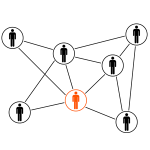 We all know what networks are. They’re arrangements of intersecting horizontal and vertical lines, or even groups of interconnected people or things. Right?
We all know what networks are. They’re arrangements of intersecting horizontal and vertical lines, or even groups of interconnected people or things. Right?
I hate to break it to you (not really) but there’s another definition, too.
Computer networks, or data networks, are a means by which multiple computers (or other devices such as printers, phones, tablets, etc.) are connected, so that they can exchange data, etc.
Computer network version 0.000001 (more-or-less) was called “The Sneakernet”. It was composed of people who transported data from one location to another by loading it onto portable media (probably a floppy drive!) and walking it from one computer to another while wearing their sneakers. Or not. Sneakers may even have been optional.
The largest (known) network of computers today is called “The Internet”. You’ve probably heard of it already. If not, then it begs the question: how are you even reading this?!
We all know what the internet is, but how often do we stop to think about how it works? I often find myself thinking about such things, but especially times like right now, when (at the time of writing this) I don’t have internet access!
To begin, let’s learn a bit about networks themselves.
Types of Networks
Networks usually fall into one of two categories. Those categories are LANs and WANs.
LAN stands for Local Area Network. These comparably small-scale operations are typically found in homes and businesses. (An intranet is very similar to a LAN, as it references an internal, local, or private network setup.)
WAN stands for Wide Area Network. This is, essentially, a reference to the internet, which spans a rather wide area.
It is possible to have access to a LAN and a WAN at the same time, usually by being a part of a LAN that has access to a WAN.
If you want to get really technical (or if you’re really into acronyms), there are some additional network categories based on size and/or purpose.
PAN stands for Personal Area Network.
MAN stands for Metropolitan Area Network.
SAN stands for Storage Area Network.
EPN stands for Enterprise Private Network.
VPN stands for Virtual Private Network.
Local Area Networking Devices
Two computers can be directly connected to one another with a crossover cable, and in theory they are then networked.
Standard networking practice, however, is to use a device that allows multiple connections at once. The following is a sampling of the most common options.
Hubs are unintelligent, wired devices that act as a central “hub” for devices on a network.
Switches are intelligent hubs that pass data onto only certain other connections, making them faster, more efficient, and more secure than hubs.
Routers are able to forward, or route, data from one network to another. In short, routers join networks together. Some routers have wireless capabilities, and are used as the “hub” for wireless networks.
Modems are devices that convert data so that it can be transmitted or received over telephone or cable lines. They are essentially devices that can connect your computer, etc. to the internet.
– Dial-up modems were the first types used. They essentially took over the phone line. Does anyone else remember the dial-up tone that they made each time a connection was being established?
– DSL modems connect via your phone line, but do not tie it up; DSL modems allow for the internet and the phone to be used at the same time.
– Cable modems use coaxial cables to establish high-speed internet connections.
These are some of the main network devices that you may run across and need to have at least heard of. There are others, but they’re beyond the scope of our topic today.
Home Network Planning
Let’s quickly examine one example of a very simple network setup, common in homes and even small businesses. Some configuration would in each case be required, but will not be explained in these brief examples.
As previously mentioned, a crossover cable can be used to connect two computers directly. A network using this method is called a “peer-to-peer network”.
More commonly, two or more computers/devices can be networked by making use of a hub or a switch; each computer plugs into the hub/switch.
A router can be used not only to network multiple computers/devices, but also to allow the network (and all of it’s devices) access to the internet through a single connection from your ISP (Internet Service Provider).
To set this up, simply plug the LAN cable from the modem into the router, instead of your computer. Also, plug the LAN cable from each computer into the router. If you plan ahead and use a wireless router, along with wireless-capable computers/devices, that’s even fewer cables to worry about!
Note: LAN cables can only be run 100 meters before the signal quality begins to deteriorate. Wireless routers have an average range of 100 feet before the signal significantly deteriorates.
Tune In
Next week, in part two, we’ll examine some details about the largest data network on the planet, and how it works.
